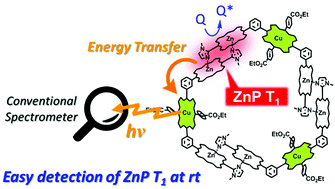Visualization of nonemissive triplet species of Zn(ii) porphyrins through Cu(ii) porphyrin emission via the reservoir mechanism in a porphyrin macroring†
Abstract
A macroring composed of three Cu(II) porphyrins (CuP) and three slipped-cofacial Zn(II) porphyrin (ZnP2) dimers exhibited near-IR emission from the CuP part. The emission lifetime of the macroring (15 μs) was 500 times longer compared to that of a Cu porphyrin monomer (e.g., Cu(II)TPP; TPP = meso-tetraphenylporphyrin). The observed emission is ascribed to emission via the reservoir mechanism from the trip-doublet (2T1) state in CuP thermally activated from the T1 state of ZnP2, which is located ca. 1030 cm−1 below the 2T1 state of CuP. The near-IR emission of the macroring was significantly quenched by O2, whereas that of the Cu porphyrin monomer was hardly quenched, indicating that the quenching event mainly occurred on the T1 state of the ZnP2 parts. The nonemissive triplet state of a Zn porphyrin at room temperature was visualized through emission from a neighboring Cu porphyrin.



 Please wait while we load your content...
Please wait while we load your content...